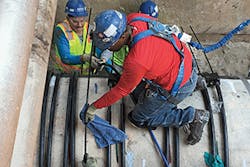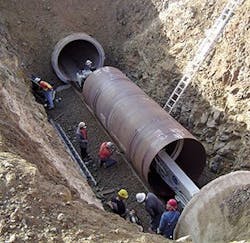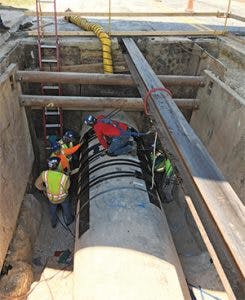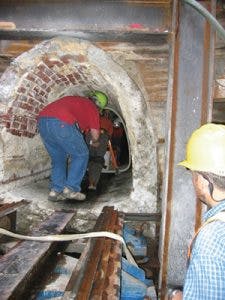Asset management has emerged as a methodology that water agencies have adopted to evaluate and manage their pipeline infrastructure. The profiles of public works and water utility departments discussed in this article reflect how, over the course of 25 years, water agencies have transitioned from replacing a pipe simply because it’s old to evaluating pipelines regularly, using multiple criteria to decide when and whether first to replace or repair pipelines facing deterioration, even potential catastrophe.
BALTIMORE PUBLIC WORKS AVERTS CATASTROPHE
The pings started at a steady rate in late May 2017, picked up by the Acoustic Fiber Optic Monitoring System in the pipeline as Baltimore Public Works engineers listened in. The pings told them that 15 wire breaks occurred over a two-week period on the Class IV prestressed concrete cylinder pipe (PCCP) known as the Southwest Transmission Main, the primary conduit for water delivery in the city and three counties.
The pipeline was located under a road beneath Interstate 195 in Baltimore, MD, and if the wire breakage had not been detected, a catastrophic break could have occurred. By June 5, contractors were excavating and found the wire breaks in a 16-foot, 54-inch diameter segment of the water main. The pipeline was repaired and back in service on June 22, 2017.
Carlos A. Espinosa, P.E., chief of the office of asset management in the Baltimore City Department of Public Works (DPW), said they worked with the Department of Transportation to divert traffic and sent water through other mains to make sure customers had water. He says DPW had awarded on-call contracts as part of their comprehensive strategy to assess the condition of larger PCCP and cast iron pipelines for just such emergencies where significant potential for major repairs exists. This is why the project could be completed in a month.
DPW hired Anchor Construction and Structural Preservation Systems under one of the on-call contracts and after excavating the pipe, workers wrapped its circumference with high-strength post-tensioning tendon cables. The repairs cost $200,000. “We were very pleased with the work because this could have been a catastrophic failure due to the enormous amount of water under pressure,” says Espinosa.
Espinosa says the DPW received the 2017 CEAM Small Project of the Year Award for the project from the County Engineering Association of Maryland on September 21, 2017.
The Baltimore Metropolitan Water System serves about 1.8 million people through 3,700 miles of pipelines in Baltimore and five counties, says Jeffrey Raymond, chief of communications for DPW. It is responsible not only for water delivery but also the sewer and stormwater infrastructure. The system provides potable water to the city and Baltimore County and sells wholesale water to two other counties, Howard and Anne Arundel. It also sells raw water to Harford and Carroll Counties.
The average age of the city’s water pipelines is 85 years and approximately 80% were installed before 1968, according to Espinosa. Most, and the oldest, are cast iron pipe, followed by PCCP. The remaining include ductile iron and steel. There is very little polyvinyl chloride (PVC) pipe, he says.
The San Diego County Water Authority (SDCWA) repaired a pre-stressed concrete cylinder pipeline in the Penasquito area of San Diego in 2003 by slip-lining a steel liner into it.
CONDITION AND CRITICALITY ASSESSMENT TOOLS
Espinosa described the condition and criticality risk model DPW uses to assess and prioritize the likelihood of pipeline failures. To determine the condition, the Office of Asset Management takes into account the history of complaints and breaks on the pipeline and the age and material of the pipes. For criticality, or the consequence of failure, the model considers the size of the pipe and the customers it serves, like Johns Hopkins and other hospitals, as well as impacts on transportation and the businesses in the area.
Once a group of pipelines or projects are selected, they are turned over to the Water Engineering Section to design and contract them out. All of this information developed by the condition and criticality risk model, including work orders, sits in a very robust geographic information system (GIS), says Espinosa.
Espinosa says DPW has a separate inspection program for evaluating PCCP and cast iron pipelines 36 inches in diameter and larger in part because of the wire breakage problem with PCCP which were installed in the 1970s. Baltimore has signed a five-year inspection contract with Pure Technologies valued at $4 million per year, with an option to extend the contract another five years. For larger PCCP, the model prioritizes water mains in data acquisition zones. Pure Technologies uses SmartBall for leak detection and its electromagnetic inspection robot Pipe Diver, when inserted in the pipeline, travels freely with the flow of water to detect the broken wires.
There are 135 miles of large PCCP and Espinosa estimates it will take 10 years to inspect the entire system of pipelines 36 inches in diameter or larger. “We have completed 18 miles in the past two years,” he says.
Pure Technologies began working with DPW in 2012 when the department asked it to inspect another portion of the Southwestern Transmission Main called Gwynns Falls. Pure Technologies completed the inspection which established the baseline condition of the pipeline. Months later, the Acoustic Fiber Optic Monitoring system, which had been installed in 2007, led to the discovery of wire breaks in the PCCP like those discovered early in 2017.
Raymond also described a series of three collapses in one concrete sewer interceptor that is about two miles long. The collapses occurred along a 1-mile section of the line over a period of several months beginning in April of 2016. About 30 feet below the surface a hole had developed in the sewer pipe and the earth above it started sinking like an hourglass allowing earth to seep into the sewer, he says. The third hole led to the street collapsing, taking with it water lines, storm drains, and electrical, gas, and fiber network infrastructure.
The work included setting up a bypass for traffic so the road could be opened up to install a structural liner inside the damaged pipe, creating a new stronger pipe inside the old, concrete sewer. The work was completed in May 2017 at a cost of more than $20 million. “It was a true headache,” says Raymond.
WATER AGENCY DECISION-MAKING EVOLVES
Pure Technologies US Inc. performs condition assessment and pipeline management services for critical infrastructure, including water and wastewater, and oil and gas agencies around the world.
Mike Higgins, senior vice president in the East Coast office of Pure Technologies, says in the late 1800s when water systems were being built, cast iron pipes were manufactured in sizes one-inch thick. “It is so robust and over-engineered that this pipe may last another 100 years,” says Higgins. Now, modern cast iron is manufactured at a thickness of ⅜ inches. Ductile iron pipe, 36-inch class 150, is ⅜ inches thick as well, but is now preferred based on performance and because it deflects better when it fails, whereas cast iron fails catastrophically.
Twenty-five years ago, agencies set aside budgets to replace pipes based solely on age. No longer, says John Galleher, vice president of Pure Technologies, based in California. Replacing pipe in this instance when the pipe has little damage is less cost-effective than replacing, say, critical valves required to operate the system safely. Furthermore, some of the best pipe is the oldest pipe, he says. On the East Coast, cast iron piping over 100 years old when excavated looks like new.
Galleher says water agencies are now taking a holistic approach to their infrastructure using GIS mapping and database recording to identify and locate all piping. Knowing what assets the agency has and where they are, how old they are, and the type of pipe and soil helps them determine the need for inspections and repairs or replacement. Galleher pointed out that a pipeline near a hospital or adjacent to a school generally is much more critical to maintain than a pipeline installed in an open space where there are no buildings.
Galleher said that the data the company has collected show that most of the piping in a water agency’s service territory is in good shape. On average, 4% has some sort of damage that can be followed for a few years before repairs are needed. About 1% of an agency’s assets need to be repaired or replaced on an annual basis, he says.
How well a pipe holds up over the years can be affected by how it was installed. Galleher explains: “There is a definite correlation between the proper design, a qualified contractor, and inspection that will impact how long a pipe will operate safely in the ground. In some cases, where all the above are perfect, a pipeline risks damage from external forces such as changes in loading on the pipeline (traffic, buildings, etc.) or new construction where the pipeline is damaged during excavation for other utilities. The majority of these types of damage to the pipeline can be avoided through proper coordination between agencies to ensure the safe and reliable operation of the pipeline. For example, a nearby construction project may require building a temporary bridge to protect the piping underground during construction.”
The location of the pipeline, the ease of getting to it, or if it is in a remote location can also impact choices of type of repairs or replacements. The type of soil can have a major impact on the type of repair, perhaps even dictating replacement. If the pipe goes under a body of water or a major highway, slip-lining may be the only option if a new pipeline proves to be infeasible or too expensive.
Higgins points out there are more options available for large diameter pressure pipes. If a water agency performs condition assessments and repairs problematic locations, a pipeline can be maintained for many decades, keeping repair costs to 5% to 10% of replacement costs. However, the industry is debating that percentage he points out.
In the end, a simple replacement is not necessarily a more cost-effective way to manage a system, says Higgins. Fundamentally, if you can find a reliable way to repair a water or distribution main, it is far less expensive and more efficient to repair it. There are now more efficient and effective ways to repair a line—for example, trenchless technologies such as slip-lining. Replacing a line versus slip-lining involves a decision on how to spend capital.
Agencies should be sharing the information they learn with other agencies and organizations like the American Water Works Association and the American Society of Civil Engineers, Galleher says. Knowledge is leaving agencies due to workforce turnover and it is not being documented. Personnel used to stay at an agency for 30 years, Galleher says, but now staff are moving from one agency to another for opportunities to move up the ladder, and the knowledge they have is moving with them.
Baltimore City Department of Public
Works (DPW) discovered wires were breaking in a prestressed concrete cylinder pipeline at an unprecedented rate in May 2017. One month later contractors were wrapping the pipe with high-strength post-tensioning tendon cables.
SAN DIEGO COUNTY WATER AUTHORITY PROACTIVE ON DETECTION
The San Diego County Water Authority was caught off-guard in 1979 when a 20-year-old prestressed concrete cylinder failed. It was located in an area with corrosive soil. And in the 1990s more problems developed with the same type of pipe.
Nathan Faber, operations and maintenance manager, says the water authority’s Board of Commissioners decided it had a problem and ordered that a pipe inspection program be developed.
The agency had been looking at the costs of replacing pipes starting in the 1980s. It concluded relining was most cost-effective and had less impact on the community. A number of its pipelines are steel, says Faber, so steel slip-lining proved to be the least expensive.
Faber says the agency began using remote field technology in October 2017 to inspect the pipe that was relined in 1979 to see how it’s holding up. “We think we can get 75 years out of it. It’s now 37 years old.”
“There actually is a case where we have to rehabilitate a pipe,” says Faber. Relining is not an option because the pipe size would be reduced. “So we’re thinking of paralleling new pipe next to the old pipe and we’ll use either steel or concrete high-pressure pipe,” he explains. In most cases, high-density polyethylene (HDPE) won’t work because it can’t withstand the higher pressures needed, he adds.
San Diego County water flows by gravity from the north in the Temecula area—at between 1,400 feet and 1,500 feet—to the south, almost to the Mexican border at 600 feet. “As you go, it goes from high to low in valleys and back up again. As long as it has enough energy it can make it.” The pressure has to be high enough at 1,400 feet to remain at 450 psi at the lowest points to continue moving up the hills.
“In general, concrete pipes aren’t designed for the highest pressures, when compared to steel,” says Faber. “If lower pressures are called for, we could use reinforced concrete cylinder pipes.”
Other problems the water authority has identified are the cracking of joints on steel pipe with steel bands which were already repaired. “We’ve had nine major failures [of these joints] since they were installed in 1948 and 1952,” says Faber. Denver Water had a similar issue “and we got together and revised standards,” he explains. “We all learn from each other.”
The San Diego Water Authority has been very proactive and has invested a lot of money in inspections, detection technologies, and repairs, says Faber. Basing inspections on technologies and data such as GPS, MRI-type scans (like those used in hospitals), and the condition of pipes helps narrow down where money should be spent. “We stay ahead of the curve on problems,” says Faber.
If people are just starting on repairs or replacement projects, Faber offers the following advice: Start small and focus on specific areas. Expand with experience. Some agencies get overwhelmed. Instead, get quick wins and give ratepayers the best value for their money.
Flowtite has been inserted in 51-inch
host pipe sections. The host pipe was originally covered with ceramic tiles.
LOS ANGELES WATER AND POWER INNOVATES TUNNELING
The Los Angeles Department of Water and Power (LADWP) chose an innovative method of tunneling when it needed to install a new trunk line under the Tujunga Wash in the San Fernando Valley to avoid damaging the wash’s infrastructure support system.
Called the Sequential Excavation Method (SEM), or colloquially, “design-as-you-go,” LADWP won two awards from the American Society of Civil Engineers Los Angeles Branch for the project.
Susan Rowghani, director of water engineering and technical services at LADWP, says the SEM methodology was developed in the 1950s and began being used in the US in the 1980s in the transportation industry. Dr. Wolfgang Roth, a member of LADWP’s technical advisory panel, recommend using it for this project, says Rowghani. “This technique is wonderful,” she adds.
The new tunnel, completed in May 2017 after 10 months of digging and laying a new trunk line, now provides a new link between the City Trunk Line’s north and south sections. This 100-year-old line is 48,000 feet in length and extends from the LA Reservoir at the north end of the San Fernando Valley to the Franklin Reservoir in the Santa Monica Mountains within the city’s boundary.
Rowghani says the trunk line, installed in 1914, is riveted steel with cement mortared lining. “It has come to the end of its life,” said Rowghani. The department has already replaced parts of the 60-inch diameter City Trunk Line and there’s more to replace. They broke it up in six phases, and the tunnel project was one of the phases.
Flowtite is being inserted into a deteriorated
pipeline that had voids. One-hundred pieces of 10-foot sections were inserted, then structural grout (5,000 psi in strength) was injected between the host line and the liner. Temporary panels provided support.
The new trunk line, also 60 inches in diameter and 252 feet long, is cement coated and lined steel. Frontier-Kemper, a subcontractor to Steve P. Rados, Inc. performed the tunneling and Rados installed the new trunk line supplied by Northwest Pipe.
Rowghani says the decision to go with the SEM or “design-as-you-go” method was due to a couple of factors. “This method was selected because of the site condition and construction risks,” she says. “We had to thread the tunnel through pilings or go deeper—between 120 feet and 150 feet below the ground to avoid the pilings.” The method used allowed the department to go only 40 to 50 feet below the ground.
“Design-as-you-go” is a misnomer, Rowghani says. First, staff has to look at the site and take borings of the soil to check conditions. Next, a design is created with flexibility built-in to allow changes in the digging of the tunnel.
Rowghani described the process: before digging begins, the insertion point is excavated and concrete is poured to reinforce the top of the hole. As drilling continues down to the 40-foot mark, supporting material is installed on the sides of the hole, along with reinforcing concrete. The supporting material and concrete are applied to the sides of the tunnel as the digging continues horizontally. Meanwhile, the design team is monitoring the digging at the site and can see what is in front of the team. If they see a deformity the design engineers can relay adjustments.
The monitoring was particularly important as the contractors threaded the digging around the pilings. Once the tunnel was completed a waterproofing membrane—geotextile—was applied over the concrete to withstand ground leaks and hydrostatic pressure. The trunk line was then inserted and the space between walls and trunk line was grouted. Cathodic protection was also installed in the pipe to prevent corrosion. “We want it to last 100 years,” says Rowghani.
Rowghani says the Asset Management Group regularly reviews pipelines—both trunk lines (above 24 inches in diameter) and distribution lines—and prioritizes work based on leakage history, corrosiveness of soil, pipe age and material, operating pressure, size, community impact, and traffic impact. “If a pipe had five leaks and inspections show deterioration, we replace it,” she says.
Meanwhile, LADWP will find out in October if its tunneling project will again be considered for ASCE’s regional awards.
LOS ANGELES SANITATION CUSTOMIZES SLIP-LINE PIPELINE
Los Angeles Sanitation kept watch over a 75-year-old clay-lined 6,000-foot sewer line under a busy intersection in central Los Angeles for 10 years. When the corrosion reached a critical point, the department decided it needed rehabilitation, according to assistant director, Adel Hagekhalil.
The sewer line runs under an intersection in Los Angeles a few blocks east of Inglewood. The department could not afford to disrupt heavy traffic and the surrounding businesses to replace the line. It knew the solution would require rehabilitation.
The department bid out the project and hired Mladen Buntich Construction Co. to construct the project when the company proposed a slip-lining approach that would reduce traffic control work. Mladen Buntich, in turn, selected Flowtite, a fiberglass reinforced polymer manufactured by Thompson Pipe Group.
Hagekhalil says slip lining minimizes the impact on the community and in many cases is faster and cheaper to install, including substantial savings on future operating costs. “It’s basically putting a new pipe inside an old one,” he says.
Complicating the engineering and installation of the Flowtite was a 90-degree turn in the 75-inch pipe located in the middle of the pipeline. It is usually very difficult to push slip-line pipe through curved sections of old pipe, especially when navigating curves. A method was devised to insert the Flowtite in short, custom-length sections with 66-inch diameters and to miter the sections at the contractor’s fabrication yard.
Each customized section was carried from the yard and installed with the joints carefully positioned and moved into place with crowbars and hydraulic jacks. Once in place, the joints were locked into position and grouted. (A detailed description of this process can be found in a case study on Thompson Pipe Company’s website, www.bit.ly/2zmm4y2.) The sewer line is now performing better than ever, Hagekhalil concludes.
INVEST IN PLANNING AND ASSESSMENT
Asset management is critical, says Hagekhalil. The department’s risk process, developed over time, scores and objectively prioritizes projects, he says. A subjective review also has its place to make sure the objective review is adequate. “If our scoring gave the project a lower risk factor, the subjective review may need to move it up.”
The condition assessment process prioritizes a project based on its age, material, structural condition, failure impact, and overall risk. This involves rating the structural condition of a pipeline, or a pump station or other equipment and assigning a letter from A—for good condition—to E, which tells the department the project is an emergency and must be handled immediately.
The overall risk of the project is rated a number on a scale from 1 to 100 and places it in line in the department’s capital investment program. The higher the score means that the risk is highest and the project has the highest priority. This score sets the schedule.
Hagekhalil says the department holds monthly meetings to review all projects where presentations cover changes and adjusted costs. Annual reviews of capital projects provide opportunities to look at projects subjectively, and not just the priority-based numbers.
In the case of the sewer line now rehabilitated, Hagekhalil says the formal assessment risk process began in July 2006. When its structural condition was rated D, and the risk factor received a score of about 60 the decision was made to put the project out for bids, says Hagekhalil.
Hagekhalil describes the average age of the sewer system at about 70 years. The older sewer lines are unlined concrete, while the sewer lines installed in the mid-‘50s are lined. “We have to be precise where we spend our money to get the best out of the lines. The goal is to invest in planning and assessments,” he says. “Assessing the condition of the system is what agencies sometimes fail to do,” he concludes.
The Water Infrastructure Finance and Innovation Act, also known as WIFIA, was approved by Congress in 2014 to accelerate investment in the US water infrastructure by providing long-term, low-cost supplemental loans for regionally and nationally significant projects. In Fiscal Year 2017, the five-year WIFIA pilot program received $25 million in funding including an additional $8 million in the Consolidated Appropriations Act of 2017 signed into law in May 2017.
WIFIA is focused on supporting large-scale projects that may be under-served by existing state revolving funds. It received 43 letters of interest from both public and private entities in response to a Notice of Funding Availability. In August 2017 it announced it had selected 12 water and sewer agencies with projects in nine states, based on their letters of interest, to apply for $2.3 billion in funding. The projects will also leverage more than $1 billion in private capital in addition to other funding, including EPA’s state revolving
fund loans.
The Baltimore City Department of Public Works was one of the 12 selected to apply for WIFIA funds for its “comprehensive infrastructure repair, rehabilitation, and replacement program.” DPW had requested $200 million. Jeffrey Raymond, chief of communications for DPW, says it took a lot of effort to apply for the application. “We’ve previously identified projects and we’re looking for funding for them,” he says.





